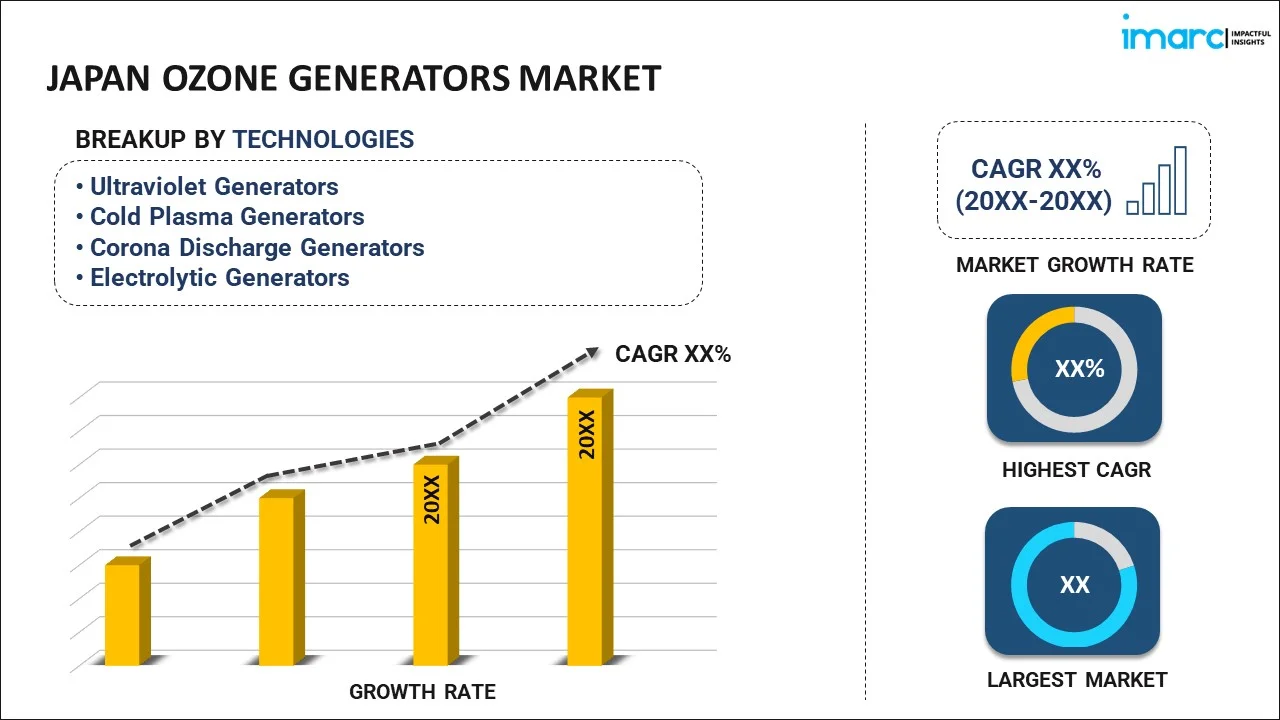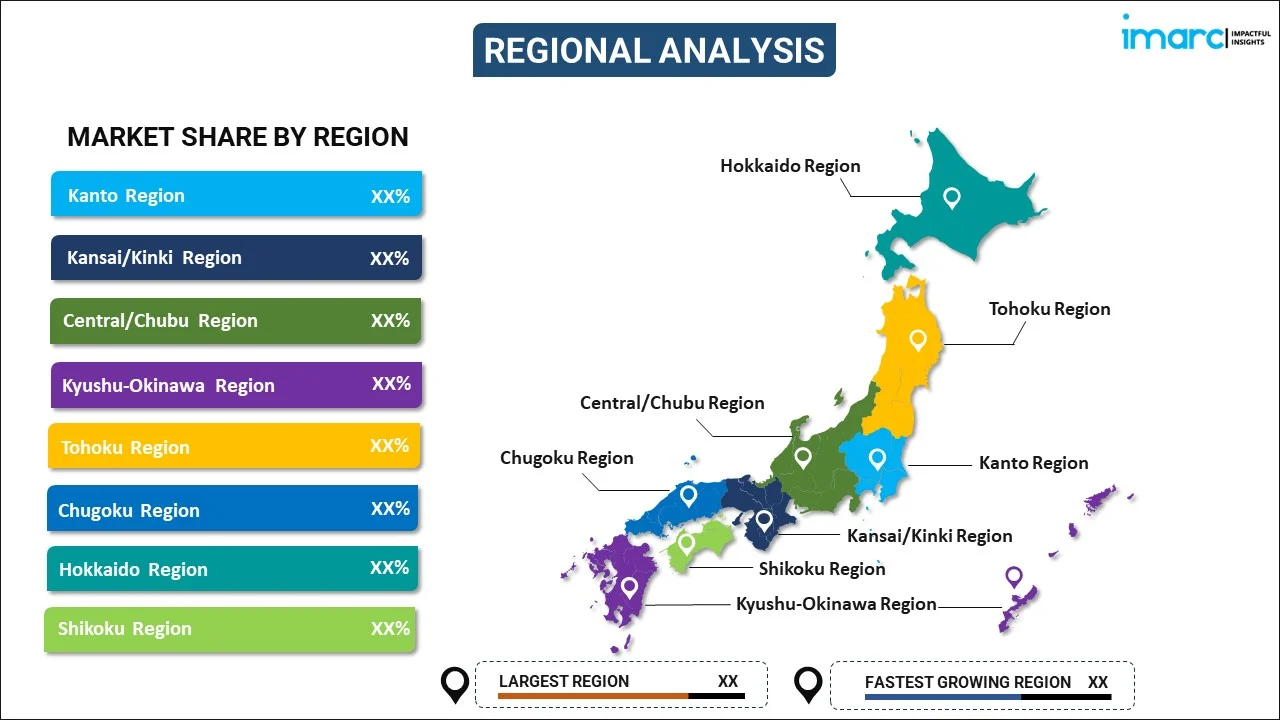
Japan Ozone Generators Market Report by Technology (Ultraviolet Generators, Cold Plasma Generators, Corona Discharge Generators, Electrolytic Generators), Application (Potable Water Treatment, Industrial Water Treatment, Air Treatment, Laboratory and Medical, Aquaculture, and Others), End User (Municipal, Industrial, Commercial, Residential), and Region 2025-2033
Market Overview:
Japan ozone generators market size reached USD 73.3 Million in 2024. Looking forward, IMARC Group expects the market to reach USD 123.0 Million by 2033, exhibiting a growth rate (CAGR) of 5.9% during 2025-2033. The rising prevalence of environmental issues, including air and water pollution, which has led to increased demand for technologies like ozone generators that can help remove pollutants and purify air and water, is primarily driving the market.
|
Report Attribute
|
Key Statistics
|
|---|---|
|
Base Year
|
2024 |
|
Forecast Years
|
2025-2033
|
|
Historical Years
|
2019-2024
|
| Market Size in 2024 | USD 73.3 Million |
| Market Forecast in 2033 | USD 123.0 Million |
| Market Growth Rate (2025-2033) | 5.9% |
Ozone generators are devices designed to produce ozone (O3), a molecule composed of three oxygen atoms. Ozone is a powerful oxidizing agent that can help eliminate odors, disinfect air and surfaces, and purify water. These generators work by using electrical discharge or ultraviolet (UV) light to convert oxygen (O2) molecules in the air into ozone molecules. Ozone generators find applications in various industries and settings, such as water treatment plants, air purification systems, and odor control in commercial and residential spaces. They are used to remove impurities, bacteria, viruses, and unwanted odors by oxidizing and breaking down these contaminants. However, the use of ozone generators should be approached with caution, as excessive exposure to ozone can have adverse health effects, including respiratory issues. It's essential to use ozone generators in accordance with safety guidelines and regulations to ensure effective and safe results while minimizing potential risks to human health and the environment. Proper maintenance and monitoring are crucial when employing ozone generators for specific applications.
Japan Ozone Generators Market Trends:
The ozone generators market in Japan has experienced remarkable growth in recent years, primarily due to several interconnected factors. Firstly, increasing awareness of the importance of air and water purification has propelled the demand for ozone generators. This growing awareness is closely linked to rising concerns about air and water pollution, which have driven individuals and businesses to seek efficient solutions. Moreover, stringent regulations on air and water quality standards imposed by governments in Japan have acted as a significant driver for the market. These regulations have prompted industries to adopt ozone generators as part of their compliance strategies. Additionally, the technological advancements in ozone generator technology have made them more energy-efficient and user-friendly, further stimulating market growth. The emergence of innovative applications, such as ozone generators for home use, has also widened the market's consumer base. In conclusion, a combination of environmental concerns, regulatory pressures, technological progress, and emerging applications is expected to drive the regional ozone generators market in the coming years.
Japan Ozone Generators Market Segmentation:
IMARC Group provides an analysis of the key trends in each segment of the market, along with forecasts at the country level for 2025-2033. Our report has categorized the market based on technology, application, and end user.
Technology Insights:

- Ultraviolet Generators
- Cold Plasma Generators
- Corona Discharge Generators
- Electrolytic Generators
The report has provided a detailed breakup and analysis of the market based on the technology. This includes ultraviolet generators, cold plasma generators, corona discharge generators, and electrolytic generators.
Application Insights:
- Potable Water Treatment
- Industrial Water Treatment
- Air Treatment
- Laboratory and Medical
- Aquaculture
- Others
A detailed breakup and analysis of the market based on the application have also been provided in the report. This includes potable water treatment, industrial water treatment, air treatment, laboratory and medical, aquaculture, and others.
End User Insights:
- Municipal
- Industrial
- Commercial
- Residential
The report has provided a detailed breakup and analysis of the market based on the end user. This includes municipal, industrial, commercial, and residential.
Regional Insights:

- Kanto Region
- Kansai/Kinki Region
- Central/ Chubu Region
- Kyushu-Okinawa Region
- Tohoku Region
- Chugoku Region
- Hokkaido Region
- Shikoku Region
The report has also provided a comprehensive analysis of all the major regional markets, which include Kanto Region, Kansai/Kinki Region, Central/ Chubu Region, Kyushu-Okinawa Region, Tohoku Region, Chugoku Region, Hokkaido Region, and Shikoku Region.
Competitive Landscape:
The market research report has also provided a comprehensive analysis of the competitive landscape in the market. Competitive analysis such as market structure, key player positioning, top winning strategies, competitive dashboard, and company evaluation quadrant has been covered in the report. Also, detailed profiles of all major companies have been provided.
Japan Ozone Generators Market Report Coverage:
| Report Features | Details |
|---|---|
| Base Year of the Analysis | 2024 |
| Historical Period | 2019-2024 |
| Forecast Period | 2025-2033 |
| Units | Million USD |
| Scope of the Report | Exploration of Historical Trends and Market Outlook, Industry Catalysts and Challenges, Segment-Wise Historical and Future Market Assessment:
|
| Technologies Covered | Ultraviolet Generators, Cold Plasma Generators, Corona Discharge Generators, Electrolytic Generators |
| Applications Covered | Potable Water Treatment, Industrial Water Treatment, Air Treatment, Laboratory and Medical, Aquaculture, Others |
| End Users Covered | Municipal, Industrial, Commercial, Residential |
| Regions Covered | Kanto Region, Kansai/Kinki Region, Central/ Chubu Region, Kyushu-Okinawa Region, Tohoku Region, Chugoku Region, Hokkaido Region, Shikoku Region |
| Customization Scope | 10% Free Customization |
| Post-Sale Analyst Support | 10-12 Weeks |
| Delivery Format | PDF and Excel through Email (We can also provide the editable version of the report in PPT/Word format on special request) |
Key Questions Answered in This Report:
- How has the Japan ozone generators market performed so far and how will it perform in the coming years?
- What has been the impact of COVID-19 on the Japan ozone generators market?
- What is the breakup of the Japan ozone generators market on the basis of technology?
- What is the breakup of the Japan ozone generators market on the basis of application?
- What is the breakup of the Japan ozone generators market on the basis of end user?
- What are the various stages in the value chain of the Japan ozone generators market?
- What are the key driving factors and challenges in the Japan ozone generators?
- What is the structure of the Japan ozone generators market and who are the key players?
- What is the degree of competition in the Japan ozone generators market?
Key Benefits for Stakeholders:
- IMARC’s industry report offers a comprehensive quantitative analysis of various market segments, historical and current market trends, market forecasts, and dynamics of the Japan ozone generators market from 2019-2033.
- The research report provides the latest information on the market drivers, challenges, and opportunities in the Japan ozone generators market.
- Porter's five forces analysis assist stakeholders in assessing the impact of new entrants, competitive rivalry, supplier power, buyer power, and the threat of substitution. It helps stakeholders to analyze the level of competition within the Japan ozone generators industry and its attractiveness.
- Competitive landscape allows stakeholders to understand their competitive environment and provides an insight into the current positions of key players in the market.
Need more help?
- Speak to our experienced analysts for insights on the current market scenarios.
- Include additional segments and countries to customize the report as per your requirement.
- Gain an unparalleled competitive advantage in your domain by understanding how to utilize the report and positively impacting your operations and revenue.
- For further assistance, please connect with our analysts.
 Inquire Before Buying
Inquire Before Buying
 Speak to an Analyst
Speak to an Analyst
 Request Brochure
Request Brochure
 Request Customization
Request Customization




.webp)




.webp)












